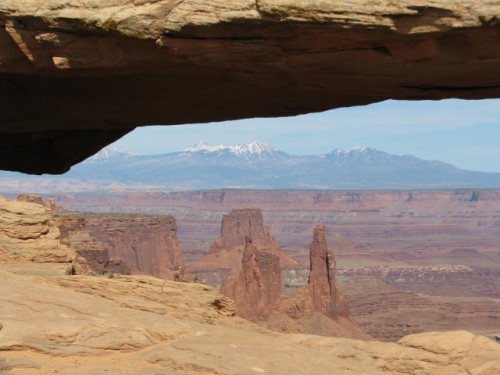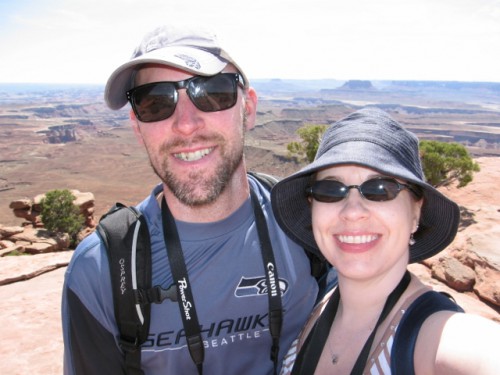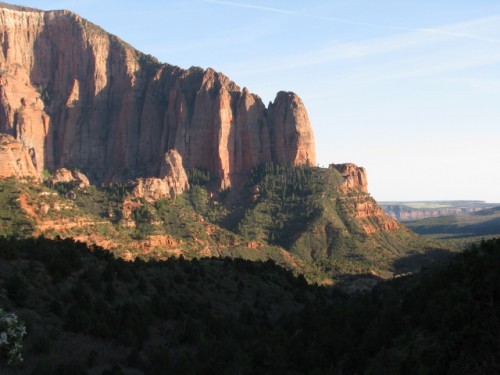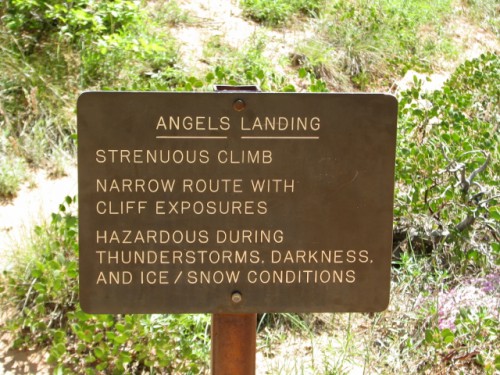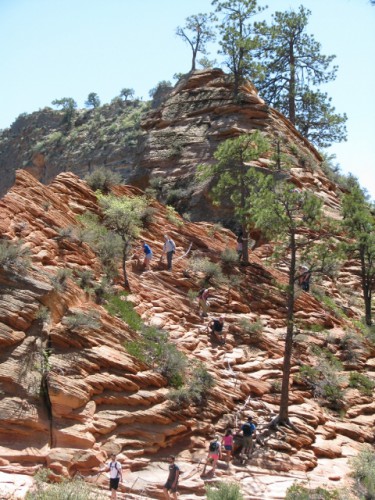In my last post, we hiked the Murphy Point Overlook Trail to one of the most scenic views I have ever experienced. After that hike, we started back the way we came and parked at the trail head for Mesa Arch. Mesa Arch is one of the most visited places in the park, for a couple of reasons – it is only a 0.6 mile round trip hike from the trail head, and it is beautiful.
Mesa Arch is one of the arches in this area that faces the sunrise, allowing photographers to get some beautiful sunrises coming up through the arch. And it is perched right on the edge of the canyon, so you can get some amazing views of the canyon through the arch. And if that weren’t enough, the picturesque La Sal Mountains can be seen in the distance through the arch. Even though we weren’t there at sunrise, the views of the canyon and the snow capped mountains in the background are stunning.
Mesa Arch, and other arches in the area form when a solid block of sandstone gets cracks in it from pressure from the Earth’s forces. The cracks get water in them when it rains or snows, and the water makes the cracks expand. Over millions of years the water erodes the sandstone, causing fins to form, and then chunks of sandstone eventually fall away. If the sandstone beneath falls away and leaves the stone above, you have an arch!
There were a lot more people at Mesa Arch than Murphy Point, but it wasn’t crowded, and everybody was really polite about taking turns so you could get a photo of the arch without anyone standing in it, or you standing next to the arch. I posed with the arch for a few photos, but of course Jon wouldn’t. All in all, it was a worthwhile short hike – I love the photos I took there.
Once we finished our Mesa Arch hike it was a little after 5. We talked about whether we wanted to do more, and decided that 4.2 miles of hiking was enough for the day. We headed back towards the park exit, and Jon was nice enough to let me stop back at the Visitor’s Center on the way out and watch the movie that we skipped earlier. It is approximately 15 minutes about the history of settlement and the geology of the park and was pretty informative. That’s when Jon and I learned that most of the roads in Canyonlands had been built to accommodate uranium mining in the 1950s! It was an interesting example of how industry can give a boost to recreation.
After leaving Canyonlands, we drove back into Moab and checked into our home for the night – another Super 8 – and discovered it is the ritziest Super 8 I have ever seen! It had granite counter tops, a built in drawer system along one wall, and laminate “wood” floors. Of course, it was also the most expensive Super 8 I have ever seen – but it was still less expensive than the other hotels we had looked at. We did a quick change of clothes so we would be prepared for the temperature drop after sundown, and made our way to the Moab Brewery for a quick dinner before our astronomy tour!
There was a 10 minute wait at the Moab Brewery, but the wait went quickly and we were able to order quickly because we had looked at the menu while we waited. Jon got the fresh salmon filet – with a dinner salad, bread, vegetables and rice pilaf. He paired his with a Black Imperial Ale; he had been craving a high octane beer for the last few days, and this one delivered at 8.59% alcohol by volume. I can only guess that the Moab Brewery is able to brew extra strong beer either because it has a hard liquor license, or because this beer is not available on tap – it is served in the bottle.
I had the Greek Pasta – sautéed sundried and fresh tomatoes, Kalamata olives & spinach in garlic, basil & olive oil, tossed with penne pasta, topped with feta cheese & parsley. It was served with garlic bread. I enjoyed it with a Dead Horse Amber Ale. The brewery was packed – the service was fast and friendly, and the décor was fun. The food wasn’t outstanding, but it was good. It was the kind of place we would love to come back to. But unfortunately we couldn’t linger long, because we had to meet our Astronomy tour guide!
Have you ever hiked to Mesa Arch or visited the Moab Brewery? I’ll post about our Astronomy tour next!


